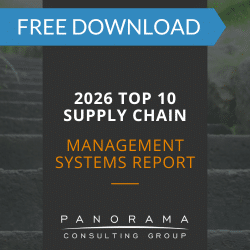ERP implementations often lack a strategic framework, and according to our 2014 ERP Report, take longer than expected, cost more than expected and fail to deliver expected business benefits. We’ve found in our years of implementation experience that the term “strategy” is too often missing from the vernacular of CIOs and CFOs about to embark on their ERP implementation strategies.
Although not many organizations are particularly good at defining their IT strategies, this is an important step in the process of identifying the best path forward with new ERP software. Below are some of the key questions that need to be defined:
- Are we more interested in a single system or best-of-breed?
- Do Tier I or Tier II ERP systems make the most sense?
- What type of deployment option is best for us?
- What do we want to outsource vs. insource?
- What is our phasing strategy?
- What organizational change management strategy should we develop?
- How much will we standardize business operations across our various locations and business units?
- Do we want to change the software to fit our business, change our business to fit the software or a combination of both?
These are just a few of the many important strategic decisions that need to be made prior to an ERP implementation. It is far too easy to jump into an ERP project and start making decisions that are not necessarily aligned with a sound, longer-term IT strategy. Answering these and other important strategic questions can be difficult without the right expertise and mindset.
To get started, below are a few things to consider and as you and your team begin making key strategic decisions and navigating your potential IT strategy for the future:
Assessment of your current IT landscape. The first step in any effective IT strategy is to assess the strengths, weaknesses and opportunities related to your current environment. You will want to benchmark your current IT situation to other organizations and best practices to prioritize the various opportunities for improvement. For example, this assessment should evaluate your current enterprise systems, physical infrastructure, data, skills and competencies among your IT staff, and a host of other considerations. Only by knowing where you are starting from can your team define the best path to where you want to be.
Alignment of IT with your current corporate strategy. Though CIOs and IT team members are important in helping the organization accomplish its long-term objectives, too many CIOs are disconnected from their organization’s overall strategy. For example, we have seen ERP project teams deploy decentralized and customized implementation strategies across their various businesses when the organization’s stated strategic objective is to standardize and centralize the business operations. Decisions regarding your ERP implementation should always be made in the context of overall company objectives and be supported by those longer-term goals. Without that alignment, your ERP implementation is more likely to be a troubled project that fails to deliver expected business benefits.
Potential strategic scenarios. Once your current IT landscape is analyzed in the context of your organization’s longer-term objectives, it is then appropriate to identify potential strategic scenarios to support the overall vision for the company. We recently worked with a multi-billion dollar organization that evaluated several potential (and diverse) options, including outsourcing their IT department, upgrading and better integrating their current systems, replacing their current systems, and standardizing operations across their global locations. Each was a potential means to achieve their overall strategy – including strengths, weaknesses and tradeoffs for each. In order to define feasible scenarios, it helps to look at what is happening in the industry and what tactics other organizations like yours are deploying.
Business case and ROI analysis. Ultimately, the strategic scenario your team chooses will be heavily influenced by the potential costs, benefits and return on investment of each. It can be easy to make an emotionally-charged decision – such as, “Our current systems don’t work correctly, so let’s go get a new ERP system” – but these potential scenarios should be evaluated in a rational, quantitatively-focused way to ensure that emotions don’t dictate the chosen approach. These quantitative comparisons of various scenarios should also consider long-term hidden costs, such as the technical and organizational costs of maintaining the particular solution. At the end of the day, your executive team and board will want to see how the costs, benefits and ROI stack up for each potential scenario you are considering.
The three- to five-year strategic roadmap. As much as we would all like to transform and improve our businesses overnight, successful initiatives are typically more of a multi-year process. Your final output from the strategic process should be a three- to five-year roadmap outlining the implementation strategy and key milestones critical to the success of the overall transformation. It is important to remember to include the following key components in your roadmap: what types of solutions will be deployed, how the organization will need to change, expected business benefits, business process reengineering strategy and the organizational change management plan.
These and other key strategic topics are covered as part of our proprietary PERFECT Plan™ IT Strategy Methodology, which we recommend and deliver for our clients that are a bit more focused on the long-term success of their various ERP initiatives. While some organizations can certainly succeed without this important step, the odds of success are much greater with the above items in mind.
Learn more by watching our on-demand webinar, How to Define the Best IT and ERP Strategy Roadmap for Your Organization.












